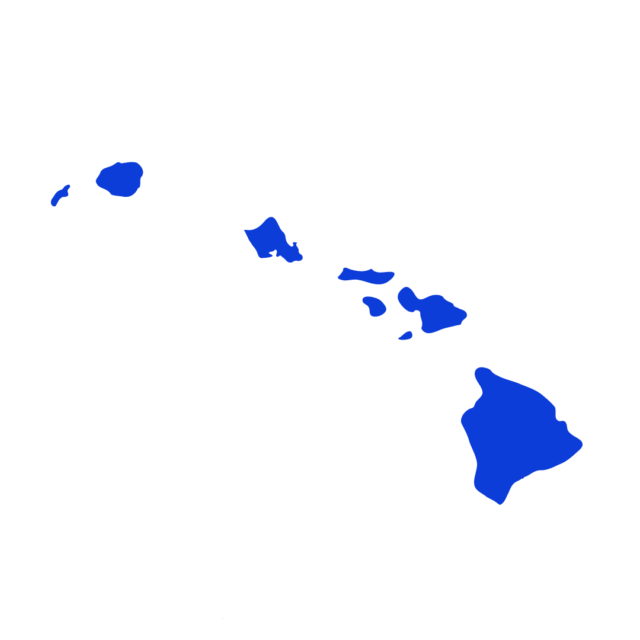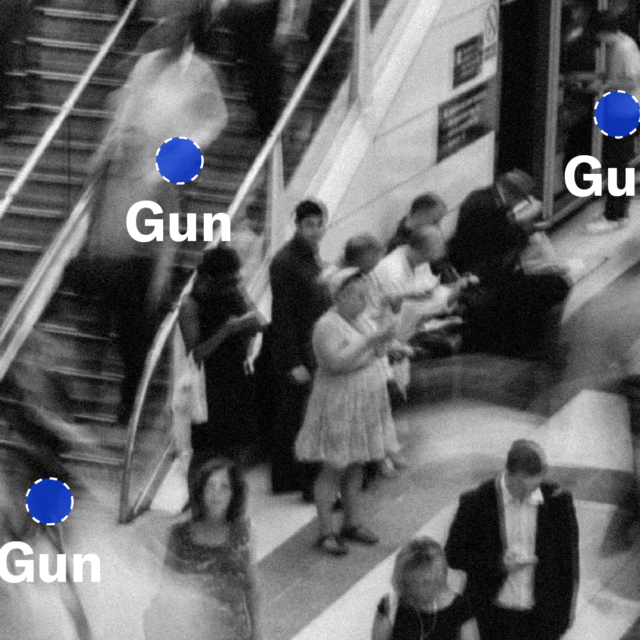At the Forefront of Gun Safety
Removing Illegal Guns
Last Updated: 5.12.2024

Introduction
In February 2019, five people were shot and killed and six were wounded at their workplace in Aurora, IL. It was yet another horrific mass shooting in an endless saga of gun violence that has shocked the country—and it is also an instructive example about the limits and the promise of good policy. Indeed, in this case our system of laws nearly worked to prevent this tragedy. The killer was legally barred from having guns after a felony conviction. Illinois officials had been able to easily find that felony record and deny his application for a concealed carry permit in 2014. At the time, they even revoked the permit that allowed him to have guns in his home. But unfortunately the system failed to take the next step to remove any weapons he already possessed at home. The future shooter was never pressed by law enforcement to sell or otherwise get rid of his Smith & Wesson handgun. He remained armed, in violation of the law—and was able to kill five people several years later.
After the shooting, Illinois officials took a close look at their suite of gun laws and highlighted what was needed: a strong program to protect the public by proactively tracking and confiscating illegal guns after a felony, a domestic violence conviction or restraining order, a long-term mental health commitment, or any other incident that bars a person from being armed. The legislature took action, and the Illinois governor signed a robust gun removal program into law in 2021. New York lawmakers followed suit in the summer of 2022, strengthening the Empire State’s gold-standard policy.
This paper, the first in an Everytown series of profiles of innovation in the gun violence prevention movement, details this groundbreaking policy. These gun removal programs, often based on “rap back” technology, build and capitalize on several other foundational laws. While gun violence continues to spike across the country, and even as some state lawmakers have endangered their constituents by repealing core laws regulating public carry, the growth in cutting-edge efforts like removal programs provides real hope about progress on new solutions to our intransigent gun violence problem.
Key Takeaways:
- These programs are at the forefront of saving lives: California authorities have removed over 23,000 guns from prohibited people in the last eight years, and Illinois officials have confiscated or confirmed surrender of over 10,000 weapons in less than three years.
- We estimate that 173,000 gun owners become newly prohibited each year—almost 10 percent of them in Texas alone—and, without strong removal programs, the vast majority of those illegal guns remain in the possession of people who shouldn’t have them.
- Six states—California, Connecticut, Hawaii, Illinois, Massachusetts, and New York—have already set up statewide removal programs, building off of and maximizing the impact of other smart gun safety tools they already have in place—and beginning to build a gold-standard policy that interrupts dangerous gun access. Washington has a mandate in place that it has yet to implement.
What Are Illegal Gun Removal Programs?
The United States is caught in a tragic gun violence crisis, with a gun death rate 13 times higher than that of other high-income countries.1Everytown analysis of the most recent year of gun deaths by country (2015 to 2019), GunPolicy.org (accessed January 7, 2022). Every year, more than 44,000 Americans are killed in acts of gun violence, and nearly 97,000 more are shot and wounded.2Centers for Disease Control and Prevention, National Center for Health Statistics. WONDER Online Database, Underlying Cause of Death. A yearly average was developed using five years of the most recent available data: 2018 to 2022. Everytown For Gun Safety Support Fund, “EveryStat: United States,” https://everystat.org/. Based on Everytown Research analysis of 2020 HCUP nonfatal injury data. That is the equivalent of more than 120 people killed in gun violence each day in the United States, with over 200 more shot and wounded.3Centers for Disease Control and Prevention, National Center for Health Statistics. WONDER Online Database, Underlying Cause of Death. A yearly average was developed using five years of the most recent available data: 2018 to 2022. Everytown For Gun Safety Support Fund, “EveryStat: United States,” https://everystat.org/. Based on Everytown Research analysis of 2020 HCUP nonfatal injury data. There are an estimated 393 million civilian-owned firearms in the United States,4Aaron Karp, “Estimating Global Civilian-Held Firearms Numbers,” Small Arms Survey, June 2018, https://bit.ly/3snZ9fH. with each one increasing the likelihood of homicide and suicide for those who have access to it.5Wiebe DJ. Homicide and suicide risks associated with firearms in the home: a national case-control study. Ann Emerg Med. 2003 Jun; 41(6):771-82. Perhaps most shockingly, a significant number of those weapons are owned by people who are legally barred from having guns—but officials simply haven’t done the work to identify and confiscate them.
Many core policies to reduce gun violence work by preventing people who pose a danger from accessing firearms. The primary piece is so-called prohibitor laws, which name the categories of people who may not have or buy guns—for example, domestic abusers and people with felony records. Next, background check and permit laws enforce those prohibitions at the time of a gun purchase, blocking those individuals from arming themselves illegally. But equally important are policies that ensure that people who acquire guns legally and then later become barred from having them are not able to keep their firearms. Laws targeting the relinquishment of illegal guns are mission-crucial for preventing harm, and states across the country over the past decade have focused in particular on the in-court removal process after a domestic abuse conviction or restraining order. While these efforts have disarmed countless abusers, they must be scaled up to cover all illegal firearms—using tools to proactively confiscate guns when people fail to turn them in. Programs like the one in California do precisely that: they identify gun owners in real time as they are convicted or otherwise become prohibited and enable law enforcement to remove guns if they are not turned in voluntarily. By targeting only illegal guns, these programs protect our communities with no impact on lawful gun owners.
The policy is essential for any sophisticated set of gun laws, as it is the only way to remove many of the weapons that pose the highest risk to the public—including from people who have newly been convicted of a serious crime or placed under a restraining order. In so many ways, it is the logical next step, leveraging several tools already in the gun safety toolbox to target illegal guns.
Six states—California, Connecticut, Hawaii, Illinois, Massachusetts, and New York—have implemented these removal programs, and should be considered the top innovators in this life-saving space. One other—Washington—has enacted a requirement for a gun removal program, but has failed so far to fulfill that mandate and start removing illegal guns. Several other states have taken a significant step towards building a program by keeping records of gun purchasers—and are well-positioned to act now and cross-check them against records of prohibiting events. While the remaining states in the country do not have records of gun purchasers, they do keep records of concealed carry permit holders—and could set up a removal program to ensure these permit holders remain eligible to carry concealed guns in public.
Six states—California, Connecticut, Hawaii, Illinois, Massachusetts, and New York—have implemented these removal programs, and should be considered the top innovators in this life-saving space.
How Removal Programs Work
These critical programs have two basic steps: first, enabling officials to identify when a gun owner has become ineligible to own firearms; and second, creating an avenue to confiscate firearms if they are not voluntarily relinquished.

Step 1: Identifying Illegal Guns
A strong system focuses on gun owners who have recently proven to be dangerous. Under federal law, a person must pass a background check before purchasing a gun from a licensed firearms dealer. The federal background check system, the National Instant Criminal Background Check System (NICS), stops tens of thousands of people with felony offenses, domestic abusers, and other prohibited people from buying guns each year. But it is only a snapshot in time at the point of purchase. The purchaser may—a day, a month, or a year later—be convicted of a felony or domestic abuse, be involuntarily committed to a psychiatric facility, or otherwise become prohibited from having a gun. The identification step of an illegal gun removal program gives officials this critical information: the knowledge that a person who purchased a firearm has a new incident and is no longer permitted to have the gun.
These programs leverage a state’s official database of gun purchasers or permit holders, cross-referencing records of newly prohibiting events from courts, mental facilities, and other relevant parties against the list of purchasers or permittees. Many of these incidents appear on traditional criminal rap sheets, and these flagging systems are therefore often called “rap back” programs. When a match is found—meaning a gun purchaser has a potentially prohibiting event—law enforcement is notified. While the records can be checked against each other in several ways, the most efficient systems require little manual labor. As an example, a court can send daily to law enforcement agencies records of all prohibiting felony convictions, and a computer program can automatically alert officials of any match with a gun owner. Importantly, while these programs rely on officials keeping records of gun purchasers, those records are generally protected from public disclosure and have not led to improper removals; see further discussion in “Other GVP Policies” below.
Step 2: Removing Illegal Guns
The second step in the process is ensuring that illegal guns are voluntarily relinquished—or else removed by law enforcement. After confirming that a gun owner has indeed become prohibited, officials investigate whether the person has already turned over their guns, perhaps through an in-court process. If not, law enforcement will take steps to disarm the person, notifying the individual that they must relinquish their firearms and identifying any guns known to be in the person’s possession. If the person refuses to turn in illegal guns, officials should confiscate them—perhaps using probation or parole searches and, if necessary, search warrants. These searches often yield illegally obtained firearms or unserialized and untraceable ghost guns, in addition to firearms that are registered in the purchaser database. Enforcement efforts may also yield ammunition and other dangerous weapons and devices. If a person later becomes no longer prohibited—for example, because a prohibiting restraining order expires—their guns may be returned.
States with illegal gun removal programs have had tremendous success, seizing thousands of illegal guns from people with a recent dangerous history.
Rap Back Systems
When a person is first entered into a rap back program, their fingerprints are entered into the system. If the person is later arrested, officials take new fingerprints, which are connected to the individual’s rap (record of arrest and prosecution) sheet. A rap back program cross-references the new prints against all prints initially submitted into the program, triggering a notification when there is a match. Some systems also provide notifications of criminal history events beyond arrests, such as convictions. These programs provide critical information in real time, obviating the need for periodic and resource-intensive manual background checks on enrollees going forward.
Rap back programs have been used to flag people who may pose a danger and ensure they are not in positions of public trust, including teachers, daycare providers, and people caring for the elderly. These programs are also used for criminal justice purposes, notifying parole or probation officers of criminal history events for individuals under their supervision. At least 34 states currently provide in-state rap back services for some purposes.6B. Goggins D. DeBacco, “Survey of State Criminal History Information Systems, 2018,” SEARCH, National Consortium for Justice Information and Statistics, November 2020, https://bit.ly/3ctEqTo. These states have already taken a major step toward illegal gun removal programs by building infrastructure that can be leveraged to identify illegal guns. As featured in this report, several states already make use of their in-state rap back programs to ensure that firearm owners may legally possess their guns on an ongoing basis. States without existing programs can look to the majority of states across the country as models to replicate.
Additionally, the FBI in 2014 launched a federal rap back program, which runs criminal history checks in real time, notifying state and local agencies of new criminal history events, and which may be used for criminal justice and non–criminal justice purposes.7FBI, “Next Generation Identification: FBI Announces Biometrics Suite’s Full Operational Capabilities,” September 23, 2014, https://bit.ly/3oIiWVZ. The FBI must approve the uses for which state and local agencies desire to use the program, and it should authorize its use to ensure that firearm owners or permit holders remain eligible for their firearms or permits. With federal approval and the appropriate requirements met, states without their own rap back programs could lean on the federal resource for notifications, so long as they meet federal requirements. Even states with existing rap back programs can benefit from the federal program, as the FBI includes notifications on criminal history events that occur in states beyond where the individual is enrolled—events that are generally not captured by an in-state program.
Illegal Gun Removal Programs Save Lives
States with illegal gun removal programs have had tremendous success, seizing thousands of illegal guns from people with a recent dangerous history. From 2014 to 2021 alone, California officials removed more than 23,000 illegal guns under their landmark removal program, including an increasing number of do-it-yourself, homemade ghost guns made from building blocks available on the Internet.8Agents seized a total of 1,428 firearms in 2021, 1,243 firearms in 2020, 2,130 firearms in 2019, 2,290 firearms in 2018, 3,685 firearms in 2017, 3,954 firearms in 2016, 5,038 firearms in 2015, and 3,286 firearms in 2014. Agents seized 39 ghost guns in 2021, 27 ghost guns in 2020, and 41 ghost guns in 2019. See the 2021 APPS Report, 2020 APPS Report, 2019 APPS Report, 2018 APPS Report, 2017 APPS Report, 2016 APPS Report, 2015 APPS Report, and 2014 APPS Report. Illinois officials have seen similar success: From 2019 to September 2021, authorities conducted more than 450 firearms enforcement actions, covering more than 1,300 prohibited persons and more than 10,000 illegal firearms,9Illinois State Police, “Illinois State Police Reduce FOID Backlogs,” September 28, 2021, https://isp.illinois.gov/Media/PressReleaseFile/695. from June 16 to July 31, 2022 alone, authorities placed more than 1,000 individuals in compliance with the state’s law.10Illinois State Police, “Illinois State Police Continues Efforts to Reduce Gun Violence Through Firearms Enforcement Blitz,” August 18, 2022, https://isp.illinois.gov/Media/CompletePressRelease/764. Each gun removal is a potential tragedy averted, a prohibited person who cannot use their firearms to cause further harm to the community or themselves.
>23,000 guns
California authorities removed over 23,000 guns from prohibited people between 2014 and 2021.
Everytown analysis of California Department of Justice, “Armed And Prohibited Persons System Report,” Annual Reports 2014–2021, https://oag.ca.gov/publications#apps. See also, Everytown for Gun Safety Support Fund, “At the Forefront of Gun Safety: Removing Illegal Guns,” November 16, 2022, https://everytownresearch.org/report/at-the-forefront-of-gun-safety-removing-illegal-guns/.
Last updated: 11.16.2022
>10,000 guns
Illinois officials have confiscated or confirmed surrender of over 10,000 guns in less than three years.
Illinois State Police, “Illinois State Police Reduce FOID Backlogs,” September 28, 2021, https://isp.illinois.gov/Media/PressReleaseFile/695.
Last updated: 9.27.2022
Indeed, without these targeted programs, thousands of illegal guns remain in the hands of prohibited people—even in states with much of the necessary policy context to act quickly. In California, an average of 10,356 gun owners each year have become prohibited from having guns.11This average covers the last five years in California. See the 2021 APPS Report. Extrapolating from that California figure, there are an estimated 173,000 gun owners who become prohibited across the country each year (based on the estimated proportion of adults living in a household with a firearm12https://www.rand.org/research/gun-policy/gun-ownership.html in each state).13California has one of the strongest sets of state firearm prohibitors in the country. The result is that a smaller percentage of the state’s population may own guns than the population in other states with weaker laws. However, a larger percentage of gun owners may become prohibited each year. This includes approximately 8,500 gun owners in Pennsylvania, 10,200 gun owners in Florida, and a whopping 15,800 gun owners in Texas. The number of illegal guns not accounted for each year is staggering—and each state needs a program to remove these weapons.14State-level estimates of prohibited gun owners were generated using US Census data on the number of adults and households in each state, from which we calculated the average number of adults per household; and the estimated percentage of adults living in gun-owning households from RAND in 2016, from which we calculated the number of adults living in gun owning households. We then calculated (1) households with a gun = number of adults living in gun owning households / average number of adults per household; (2) number of adult gun owners = households with a gun * 64.0 percent, where 64.0 percent was a constant across states extrapolated from California’s report that the number of adult gun owners per household was 1.36 (out of 2.34 total adults per household in the state, or 64.0 percent), and finally; (3) the number of newly prohibited adult gun owners = the number of adult gun owners * 0.32 percent, where 0.32 percent also was a constant across states extrapolated from California’s report that 0.32 percent of adult gun owners were newly prohibited annually (2021 APPS Report). The California APPS program (and the statistics set forth in the annual reports) includes records of handgun sales since 1996 and records of long gun sales since 2014. Due to the lack of relevant data in other states, our calculations assume that for all states (1) the average number of adults per household is constant regardless of whether there is a gun in the home, (2) 58.1 percent of people in gun owning households are adults, and (3) the percentage of gun owners who become prohibited annually is 0.32 percent.
While we are not aware of any research on the efficacy of statewide illegal gun removal programs specifically,15Research on California’s illegal gun removal program is currently underway. See Garen J. Wintemute, Laurel Beckett, Philip H. Kass, Daniel Tancredi, et al., “Evaluation of California’s Armed and Prohibited Persons System: Study Protocol for a Cluster-Randomised Trial,” Injury Prevention 23, no. 5 (2017): 358,
https://injuryprevention.bmj.com/content/23/5/358.abstract. We are aware of one paper, however, that sought to characterize all of the individuals in the APPS program: V. Pear et al., “Armed and Prohibited: Characteristics of Unlawful Owners of Legally Purchased Firearms,” Injury Prevention 27, no. 2 (March 2020), https://injuryprevention.bmj.com/content/27/2/145. the available science consistently shows that laws requiring prohibited persons to surrender firearms are associated with reductions in gun violence. One study found that state laws prohibiting domestic abusers under restraining orders and requiring them to surrender their guns were associated with a 14 percent reduction in firearm-related intimate partner homicide and almost a 10 percent drop in overall intimate partner homicide. And the surrender element appears to be crucial, as the same study found that laws prohibiting gun possession—but not affirmatively requiring surrender—were not associated with homicide rates.16Carolina Díez, Rachel P. Kurland, Emily F. Rothman, Megan Bair-Merritt, Eric Fleegler, Ziming Xuan, Sandro Galea, et al., “State Intimate Partner Violence–Related Firearm Laws and Intimate Partner Homicide Rates in the United States, 1991 to 2015,” Annals of Internal Medicine 167, no. 8 (2017): 536–43. Another study found that domestic violence restraining order laws that included relinquishment provisions were associated with 12 percent lower firearm-related intimate partner homicide, whereas the effect of laws with the prohibition but no surrender requirement was unclear.17April M. Zeoli, Alexander McCourt, Shani Buggs, Shannon Frattaroli, David Lilley, and Daniel W. Webster. “Retracted: Analysis of the Strength of Legal Firearms Restrictions for Perpetrators of Domestic Violence and Their Associations with Intimate Partner Homicide,” American Journal of Epidemiology 187, no. 7 (2018): 1449–55. Additional studies have found similar effects.18See, e.g., Tiara C. Willie, Trace Kershaw, Rachel Perler, Amy Caplon, Marina Katague, and Tami P. Sullivan, “Associations between State Intimate Partner Violence–Related Firearm Policies and Injuries among Women and Men Who Experience Intimate Partner Violence,” Injury Epidemiology 8, no. 1 (February 22, 2021): 8, https://doi.org/10.1186/s40621-021-00297-y.
Examples of Successful Removals
Several recent cases from California demonstrate the immediate and substantial impact these programs can have in preventing gun violence:
- In November 2021, agents seized two assault weapons (one of which was a ghost gun), four lower-receiver firearms, two handguns, more than 50 magazines (28 of which were large-capacity), and more than 6,600 rounds of ammunition from a prohibited individual identified by the state’s removal program.12021 APPS Report.
- In February 2021, agents seized two ghost guns—an unserialized fully automatic machine gun with an attached silencer and an unserialized short-barreled fully automatic machine gun—two shotguns, three handguns, a 60-round drum magazine, a second high-capacity magazine, 11 handgun magazines, and 7,000 rounds of ammunition from an individual prohibited as a result of a history of mental illness.22021 APPS Report.
- In June 2020, agents seized 12 handguns, four rifles, two shotguns, one assault weapon, 18 magazines (including three high-capacity magazines), and nearly 3,500 rounds of ammunition from the residence of a person flagged by the removal program.32020 APPS Report.
- In 2018, agents seized two guns (including a ghost gun), high-capacity magazines, and ammunition from a person with a felony conviction who admitted to prior membership in a criminal street gang—all removed from a house with seven children under the age of 12.42018 APPS Report.
New Focus on Removal Programs in the States
State leaders in gun safety policy have sought innovative ways to combat the ongoing surge of violence across the country—and have increasingly turned to gun removal programs through legislation, policy, and ballot measures to protect their residents.
States With Established Removal Programs

-
California
In 2001, California became the first state to mandate a gun removal program by statute, and in 2006 implemented its landmark Armed and Prohibited Persons System (APPS).19SB 950, Stat. 2001, ch. 944. The system monitors several state databases for prohibiting events and cross-references this information against known firearm owners in the state. After determining that the gun owner has become prohibited, analysts investigate, and state agents—often in conjunction with local law enforcement—seek voluntary relinquishment or else confiscate illegal guns. Officials have developed strategies for how to prioritize cases, often focusing on individuals under gun violence restraining orders and recent ammunition purchasers.

-
Connecticut
While Connecticut’s program is not mandated by statute, it has been part of daily operations in the Department of Emergency Services and Public Protection’s Firearm Unit for several years. Courts, mental health facilities, and other entities with relevant information regularly send records of potentially prohibiting events to the Firearm Unit, which analyzes the information to determine if a gun purchaser has indeed become prohibited. State police then send information regarding the prohibited purchaser to local law enforcement, which is responsible for ensuring that firearms are removed. When the enforcement step is complete, the individual must provide local law enforcement with a compliance statement affirming that all of their guns have been surrendered or transferred. Local law enforcement forwards the compliance statement, along with a statement of what transpired, back to the Firearm Unit for recordkeeping purposes.

-
Hawaii
Hawaii lawmakers first enacted the state’s program in 2016,20Senate Bill 2954 (2016). and in 2021 officials launched a system which relies on the state’s rap back service. The system cross-references records of arrests against records of gun owners21HRS § 134-3. and sends notifications to local law enforcement agencies when there is a match. Local law enforcement determines whether the individual is prohibited and prepares steps for removing the guns. Hawaii’s infrastructure was originally built to integrate the FBI’s rap back service,22Attorney General, State of Hawaii, “Facts Sheet: SB 2954 (Act 108, SLH 2016), accessed August 10, 2022, https://ag.hawaii.gov/wp-content/uploads/2013/01/Rap-Back-Facts-Sheet-Final-12-7-16-002.pdf. but the FBI has not yet approved the state’s request to use the federal service for firearm eligibility purposes. As a result, subscribing law enforcement agencies receive alerts from the state rap back service only—allowing them to see in real time records of arrests in Hawaii, but not records of criminal events that may have occurred elsewhere in the country.

-
Illinois
An individual must have a Firearm Owner’s Identification Card (FOID) to possess a firearm in Illinois. When any FOID holder becomes prohibited, officials must revoke the card, setting off requirements for the person to transfer any and all firearms and to file a Firearm Disposition Record that records those transfers.23430 ILCS § 65/8; 430 ILCS § 65/9.5. In 2021, after the Aurora shooting, Illinois passed legislation to strengthen and fund the enforcement of this process. The new law statutorily requires the Illinois State Police (ISP) to monitor databases for firearm prohibitors and to “correlate” those records with FOID records. It also requires the ISP to create and maintain a portal for law enforcement showing FOID cards that have been revoked and to establish a task force responsible for collaborating with local law enforcement to conduct enforcement operations. Critically, the bill redirects funding in part to help fund revocation and enforcement details.24House Bill 562 (2021).
-
More on Illinois
The 2019 shooting in Aurora at the Henry Pratt Company highlighted the importance of firearm removal enforcement efforts. Indeed, an audit of the FOID program found that only about 45 percent of FOID cards revoked in 2018 and 2019 were ultimately turned in to law enforcement, and records of firearm surrender were filed in only one out of every three revocations.1State of Illinois, Office of the Auditor General, “Management Audit of the Firearm Owner’s Identification Card and Concealed Carry License Programs,” September 29, 2021, https://www.auditor.illinois.gov/Audit-Reports/Performance-Special-Multi/Performance-Audits/2021_Releases/21-FOID-CCL-Programs-Mgmt-Audit-Full.pdf. A Chicago Tribune analysis of ISP data found that of the more than 34,000 Illinois residents who had their FOID revoked between 2015 and 2019, nearly 80 percent failed to inform authorities what they did with their guns. More than half of the individuals who had their FOID cards revoked still kept them despite direct orders to relinquish them. The analyses also revealed that of the 10,500 FOID cards revoked for domestic violence–related reasons, 81 percent of those individuals never accounted for their guns; and of the 10,000 FOID cards revoked for mental health–related concerns, firearms were not accounted for in approximately 75 percent of those cases. Additionally, nine of the 157 Cook County residents who used a firearm to commit suicide in 2018 had a revoked FOID card.2Annie Sweeney, Stacy St. Clair, Cecilia Reyes, and Sarah Freishtat, “More Than 34,000 Illinoisians Have Lost Their Right to Own a Gun. Nearly 80% May Still Be Armed,” Chicago Tribune, May 23, 2019, https://www.chicagotribune.com/news/ct-met-illinois-guns-foid-cards-revoked-20190520-story.html.
Illinois has since made tremendous progress in enforcement of FOID revocation and firearm seizure efforts. As previously described, from 2019 to September 2021 alone, the ISP accounted for over 10,000 guns through their removal program. The ISP also established a Prohibited Persons Portal and an Office of Firearms Safety to create consistent procedures for revocation enforcement. The State Police Revocation Enforcement Fund was also established.3Illinois State Police, “Illinois State Police Reduce FOID Backlogs.”

-
Massachusetts
Under Massachusetts law, a person must have a license in order to possess a firearm.25A concealed carry license allows a person to possess a handgun or a long gun, whereas a firearm identification card allows a person to have a long gun. The state has developed its own in-state rap back system, which notifies the relevant firearms licensing officers when any license holder becomes subject to an arraignment, warrant, or restraining order. Issuers then review the record to determine whether any action is required, including whether the license should be revoked or suspended. The system keeps centralized records of all license revocations and suspensions across the state.

-
New York
New York’s landmark gun safety legislation passed in 2013 contained several critical gun safety policies, including a requirement for the state police to create a statewide database of handgun license holders.26Senate Bill 2230 (2013). Pre-existing state law requires an individual to obtain a license from local authorities in order to have a handgun, a license that must include the make, model, and serial number of the individual’s handguns. The 2013 law required the database to be “periodically” checked against criminal, mental health, and other records to determine whether a person has become prohibited27Senate Bill 2230 (2013), Sec. 49 (codified at NY CLS Penal 400.02).—and if authorities determine that a person is no longer eligible for a license, they must revoke the license, triggering firearm removal requirements.28NY CLS Penal 400.02; 2013 NY Senate Bill 2230 (sec. 49); referring to 400.00(11). It took New York officials several years to create the database, but more recently have launched their system. In 2022 the legislature redoubled their efforts, revisiting and strengthening the statutory requirement—which now affirmatively requires a monthly check against prohibiting records and includes records of new semiautomatic rifle licenses.29Senate Bill 9458 (2021), Senate Bill 51001(2022).
An Unfulfilled Mandate

-
Washington State
A ballot initiative approved by Washington voters in 201830Initiative 1639. requires the state Department of Licensing, in conjunction with the state police and other law enforcement agencies, to develop a process to verify “at least annually” that the owner of a pistol or semiautomatic assault rifle remains eligible to possess a firearm. The process must include notification to law enforcement, along with steps to ensure the owner does not continue to possess firearms illegally. The Department of Licensing continues to consider how best to implement the process, which it may launch in tandem with the state’s new centralized background check system, expected in 2024.31Washington State Department of Licensing, “Firearms Eligibility Report,” July 2020, https://www.dol.wa.gov/business/firearms/docs/FirearmsEligibilityReport2020.pdf; 2019 WA HB 2467.
Which States Are Next?
All 50 states should aspire to systems like the ones detailed here. Several have a head start, however: Officials in at least 6 states—Maryland, Michigan, North Carolina, New Jersey, Oregon, and Pennsylvania—and Washington, DC, maintain databases of some firearm purchasers or holders of purchase permits. While the contents of the records vary, all of these states hold critical knowledge that can be used by a rap back–type system to identify illegal guns, which officials can then work to remove. Indeed, three of these states—Maryland, Michigan, and New Jersey—already have in-state rap back systems which are used for both criminal and noncriminal justice purposes.32Goggins and DeBacco, “Survey of State Criminal History Information Systems.” Officials in these states could work to simply connect these pieces of existing infrastructure and catch up with the gun removal work of states like California and Illinois.
What’s more, every state in the nation (with the exception of Vermont) issues permits to carry concealed handguns.33In many states, permits are not required in order to carry concealed handguns in public, but a person may choose to obtain a permit for other reasons, including concealed carry reciprocity, or in some cases, serving as an alternative to a Brady background check. States can maintain records of all carry permit holders and establish a system to notify authorities when a holder becomes disqualified from having the permit or having guns—enabling authorities to seize permits or firearms as necessary. States with existing rap back programs for non-firearms purposes (see more later) will also have an easier time constructing their gun removal programs. Thirty-three of these states already have in-state rap back systems,34AL, AK, AZ, AR, CA, CO, DE, FL, HI, IL, KS, KY, LA, ME, MD, MA, MI, MN, MO, NE, NV, NJ, NM, NY, OH, OK, RI, SC, TN, TX, UT, VA, and WV. See Goggins and DeBacco, “Survey of State Criminal History Information Systems.” which could be cross-referenced against records of concealed carry permit holders to notify officials regarding permit holders who have subsequent criminal events. Several states, including Colorado, Nevada, and Michigan, have already set up such a system.35Goggins and DeBacco, “Survey of State Criminal History Information Systems.”
However, although 49 states issue permits to carry concealed handguns, 25 states36AL, AK, AZ, AR, GA, ID, IN, IA, KS, KY, ME, MS, MO, MT, NH, ND, OH, OK, SD, TN, TX, UT, VT, WV, and WY. For the most up-to-date list of states visit: https://everytownresearch.org/rankings/law/concealed-carry-permit-required/. have “permitless carry” laws—meaning that residents are not required to obtain the permit in order to carry a concealed gun in public.37A person who desires to carry a concealed handgun in public may choose to apply for a permit. A permit may allow the holder to carry concealed handguns in other states, may serve as an alternative to a federal background check when purchasing a gun from a licensed dealer, and may allow the holder to carry concealed handguns in locations where guns are otherwise prohibited. Without a permit requirement, not only does a state lack the ability to implement core public safety standards like background checks and training when concealed guns are carried in public, but it also puts these states at a significant disadvantage with respect to removal programs for concealed carry permits holders. For states with no comprehensive records of who is carrying concealed guns in public, a person can evade the oversight of a removal program by simply choosing to not apply for the carry permit.
The Programs Build Off the Successes of Other Foundational GVP Policies
Gun removal programs represent the culmination of years of dedicated state legislative work to keep guns out of the wrong hands. Indeed, without these programs in place, leading policy makers are failing to maximize the tools they have already painstakingly built to fight gun violence.
- Background Checks on All Gun Sales
Background checks are the foundation of any comprehensive gun violence policy. While federal law requires background checks for all gun sales by licensed gun dealers, it does not require any process for guns sold by unlicensed sellers, including non-dealers who sell guns online or at gun shows. When states pass laws to close this loophole and require background checks on all gun sales within their borders, they enforce gun prohibitor laws by blocking domestic abusers and people with felony offenses from buying firearms with no questions asked. But while background checks ensure that a would-be gun purchaser is not legally barred, they offer only a one time view into a person’s history—and do not interrupt gun access after purchase, for example, for a gun owner who commits a violent crime and loses their gun rights. - Notifying Law Enforcement of Failed Background Checks
It is unlawful for a person who is prohibited from buying a gun to attempt to purchase one. A robust system requires state officials or firearm dealers to notify their local counterparts when a prohibited person tries to buy a gun and fails the background check, giving law enforcement an opportunity to intervene before the person can illegally obtain a firearm or do further harm. Indeed, the bipartisan Violence Against Women Act (VAWA) reauthorization, enacted by Congress in March 2022, requires the Department of Justice to alert in-state officials whenever a person fails a gun background check. Like background checks themselves, these notifications serve as an important tool for enforcing the law on who may have guns—but do not cover people who buy guns legally and then later become prohibited. - Relinquishment
While background check laws and denial notification laws enforce our laws when prohibited people try to acquire new guns, relinquishment laws target guns already owned at the time of prohibition. Although federal laws prohibit certain categories of people from having guns, they have no affirmative requirement that firearms be turned in upon prohibition and no process for doing so. States may take on this responsibility and require surrender of illegal guns. Eight states and the District of Columbia38CA, CT, DC, HI, IL, MA, NV, NY, and PA. require all prohibited people to turn in firearms immediately, while a larger set of states—23 states and the District of Columbia39CA, CO, CT, DC, HI, IA, IL, LA, MA, MD, MN, NC, NH, NJ, NM, NV, NY, OR, PA, RI, TN, VA, WA, and WI. These states require a person who is subject to a domestic violence restraining order or who has been convicted of a domestic violence misdemeanor to relinquish their firearms.—require at least domestic abusers to do so. These laws are absolutely essential, but they have not proven to be comprehensive in removing illegal guns: In Rhode Island, for example, judges failed to follow the law and require firearm surrender for domestic abusers under restraining orders in two thirds of all cases. A statewide program like the one California has modeled for the nation can close this gap, proactively identifying and confiscating weapons. - Gun Purchaser Databases
Keeping thorough records of gun purchasers is a critical policy with several protective uses, enabling officials to trace recovered crime guns, ensure a criminal suspect or other person who poses a threat is disarmed, and build a culture of accountability for gun owners. While these records contain identifying information of gun buyers, raising potential privacy concerns, nearly all states with buyer information have been keeping records for decades, without removing guns improperly or otherwise disrupting the lives of lawful gun owners. Even though the gun lobby has suggested that allowing any records of gun ownership would lead to confiscation, in truth a large percentage of Americans live in states with these tools and there has not been any pattern of misuse. Indeed, these records are generally not accessible by the public and may only be used for specified law enforcement purposes. For example, Connecticut law states that officials “shall not disclose any records divulging or tending to divulge the names and addresses of persons who own or possess firearms, rifles, shotguns, machine guns and ammunition … and names and addresses of persons licensed to carry or possess … except [criminal justice agencies] and except to the extent such information relates solely to the person making the request and is necessary to the official interests of the entity making the request.”40ALM GL ch. 66, § 10B
These records are the backbone of any illegal gun removal program and serve two distinct purposes: first, information on the identity of a purchaser allows officials to pinpoint individuals who become prohibited; and second, information relating to specific firearms enables law enforcement to confirm that the person has surrendered all of their weapons. The most comprehensive databases include records covering all acquisitions—including purchases from dealers and unlicensed sellers alike—as well as all types of firearms, including handguns and long guns. The most useful sales records detail the purchased firearm, with the make, model, and serial number transcribed on the record. Without these records, officials have no way of knowing if a person who has a new felony conviction or other prohibiting event still has guns in their possession—or whether they have actually turned in all their weapons.
These policies are all critical for the ultimate goal of keeping guns out of the wrong hands. Background checks stop prohibited people from buying new guns, denial notification laws alert law enforcement when a prohibited person tries to buy one, and relinquishment laws require a prohibited person to turn in guns they already own. But a critical and missing piece in this robust set of gun safety policies is an accountability system—a program to ensure that all prohibited individuals are disarmed. While the strongest relinquishment laws delineate some rules for turning in guns, gun removal programs use purchaser records to set up a real-time process—tapping officials to retrieve illegal guns and realizing the promise of the policy work already done to protect the public.
Gun removal programs represent the culmination of years of dedicated state legislative work to keep guns out of the wrong hands.
Funding
Building the Infrastructure
Many states already have infrastructure in place that can be leveraged to notify authorities when a gun owner—or concealed carry permit-holder—has a criminal history event. States without that existing infrastructure can apply for federal grant funding to help build a program—including by tapping NICS Act Record Improvement Program (NARIP) grants and/or National Criminal History Improvement Program (NCHIP) grants.41NCHIP grants may be awarded “to improve the quality, timeliness, and immediate accessibility of criminal history records and related information.” NARIP funding is provided to “enhanc[e] the completeness, automation, and transmittal of records to state and federal systems used by the NICS.” See Bureau of Justice Statistics, “National Criminal History Improvement Program,” accessed August 10, 2022, https://bjs.ojp.gov/programs/national-criminal-history-improvement-program; U.S. Department of Justice, Office of Justice Programs, Bureau of Justice Statistics, FY 2022 NICS Act Record Improvement Program,” March 24, 2022, https://bjs.ojp.gov/content/pub/pdf/narip22_sol.pdf. States have successfully applied for federal grant funding to help build their in-state rap back systems used for firearm purposes. Hawaii received significant grant funding to pay for the construction of its rap back service.42See, for example, Bureau of Justice Statistics, “FY 2017 Hawaii NCHIP,” September 19, 2017, https://bjs.ojp.gov/funding/awards/2017-ru-bx-k032. While Idaho continues to await legislative authority to implement its rap back system, which it intends to use for concealed carry permit holders, it received substantial NARIP funding for its construction—including more than $230,000 in 2013 alone.43FY 2013 NICS Act Record Improvement Program (NARIP)—Summary of Activities, https://bjs.ojp.gov/sites/g/files/xyckuh236/files/media/document/fy_2013_narip_award_summaries.pdf.
Seizing Illegal Guns
A reliable funding source is crucial to make any program sustainable and successful—both to set up the relevant technology and to fund dedicated personnel at the state and local levels to facilitate firearm removal. The California legislature has provided significant funding for enforcement efforts through traditional appropriations as well as through passing costs to gun purchasers via fees. The California program has used up to $10 million in funding per year, equating to approximately $1 per four people. Indeed, the legislature periodically appropriates large sums for APPS, including a $24 million allocation in 2013. More recently, the 2019–2020 budget included a $3 million allocation,44San Diego and Alameda Counties each received $1 million and Ventura and Santa Cruz Counties received $750,000 and $250,000, respectively. and the 2021–2022 budget included a total of $10 million over two grant cycles to support local officials’ gun removal work.45Office of the Attorney General, California Department of Justice, “Attorney General Bonta Announces over $4.9 Million in Grant Funding Awarded to 10 Sheriff’s Departments to Help Seize Weapons from Prohibited Persons,” press release, December 22, 2201, bit.ly/3OPr2Xe. In the first grant cycle, 10 county sheriff’s departments were awarded grants to support activities related to seizing firearms and ammunition from individuals prohibited from owning or possessing them. The sheriff’s departments of Contra Costa, Lake, Los Angeles, Orange, Sacramento, San Francisco, Santa Barbara, Santa Clara, Santa Cruz, and Ventura Counties received grant funding through the first cycle of the department’s Gun Violence Reduction Program. Similarly, Illinois has recognized the importance of funding, reallocating fees on FOID cards to augment moneys for enforcement work.46Illinois House Bill 562 (2021), 430 ILCS § 65/5. While California officials have successfully removed tens of thousands of firearms from prohibited gun owners through APPS, a backlog remains in the system, partially resulting from intractable cases in which officials exhausted all leads but were unable to seize firearms and part of which can only be tackled with the proper resources obtained via a secure and consistent funding source.
Programs Should Be Tailored to State and Local Needs
The structure of gun removal programs should be tailored to a jurisdiction’s needs, resources, and existing tools. For example, a program can be fully centralized, with one state agency responsible for identifying prohibited purchasers and for removing illegal firearms; decentralized, with local officials assuming all of the responsibility; or a combination of the two, with state and local agencies working together. States can employ dedicated enforcement teams or leverage existing task forces to locate and seize firearms. Hawaii’s program, for example, is structured as an entirely local program due to the state’s geography and existing infrastructure. While state officials47The Hawaii Criminal Justice Data Center, https://ag.hawaii.gov/hcjdc/. built the technology for the program, notifications are sent to local law enforcement, who have the responsibility to review the information and take steps to remove firearms.
California, a state with more than seven million adults living in a household with a firearm,48RAND Corporation, “Gun Ownership in America,” accessed August 10, 2022, https://www.rand.org/research/gun-policy/gun-ownership.html; U.S. Census Bureau (2021), QuickFacts, https://www.census.gov/quickfacts/CA. uses a mix of strategies. The state Department of Justice performs the work of identifying illegal purchasers. State agents often proceed with enforcement action directly; in other cases, they send the information to local law enforcement, delegating responsibility for removal. Indeed, in January 2022, the California attorney general awarded over $4.9 million to 10 county sheriff’s departments through the state Department of Justice’s Gun Violence Reduction Program to strengthen seizure efforts.49Office of the Attorney General, California Department of Justice, “California Department of Justice Releases 2021 Armed and Prohibited Persons System Program Annual Report,” March 30, 2022, bit.ly/3vuuGyQ. California also conducts regional sweeps, during which state and local agencies collaborate in a single jurisdiction for multiple days to conduct investigations. In 2021, four regional sweeps were conducted, investigating nearly 1,300 cases which led to almost 300 firearm seizures—including 12 ghost guns and eight assault weapons.502021 APPS Report. Collaborations among state, local, and federal agencies, including the Contra Costa County Anti-Violence Support Effort Task Force (CASE)51The representatives of the CASE Task Force include individuals from the California Department of Justice, Bureau of Firearms; Contra Costa County Probation Department; Federal Bureau of Alcohol, Tobacco, Firearms, and Explosives; San Francisco District Attorney’s Office; California Department of Corrections and Rehabilitation; and the California Highway Patrol. and the Tulare County Agencies Regional Gun Violence Enforcement Team (TARGET),52The representatives of the TARGET Task Force include individuals from the California Department of Corrections and Rehabilitation; California Department of Justice, Bureau of Firearms; Porterville Police Department; Tulare County Sheriff’s Department; and the Visalia Police Department. have also seen significant success: in 2021, CASE conducted 93 APPS and other firearms-related investigations and seized 62 firearms, and TARGET conducted 169 investigations and seized 90 firearms.532021 APPS Report. Similarly, Illinois State Police announced it will provide $2 million in grants to local law enforcement agencies to collaborate on firearm enforcement efforts, including reducing and preventing illegal firearm possession.54Illinois State Police, “Illinois State Police Continues Efforts to Reduce Gun Violence Through Firearms Enforcement Blitz.”
1/4
One in four mass shootings with four or more people killed from 2015 to 2022 involved shooters who were legally prohibited from possessing firearms at the time of the shooting.
Everytown for Gun Safety Support Fund, “Mass Shootings in the United States,” March 2023, https://everytownresearch.org/mass-shooting-report/.
Cases/Examples
-
Mass Shootings
One in four mass shootings with four or more people killed from 2015 to 2022 involved shooters who were legally prohibited from possessing firearms at the time of the shooting.55Everytown for Gun Safety Support Fund, “Mass Shootings in the United States,” March 2023, https://everytownresearch.org/mass-shooting-report/. These shootings resulted in 245 deaths and 117 injuries that may have been prevented by ensuring that firearms were removed from prohibited individuals.56Everytown for Gun Safety Support Fund, “Mass Shootings in the United States,” March 2023, https://everytownresearch.org/mass-shooting-report/.
-
Milwaukee, WI
In April 2020, a man prohibited from possessing firearms because of a domestic violence conviction shot five people, including four teenagers, in a home in Milwaukee, Wisconsin.57Everytown for Gun Safety Support Fund, Everytown Research and Policy, “Mass Shootings in America.”
-
Midland-Odessa, TX
In August 2019, a man shot and killed 7 people and wounded 25 more in Midland-Odessa, Texas. The shooter had previously failed a federal background check due to his mental health history.58Everytown for Gun Safety Support Fund, Everytown Research and Policy, “Mass Shootings in America.”
-
Detroit, MI
In February 2018, a man prohibited from having guns due to multiple felony convictions shot and killed four people, including the mother of his child, in Detroit, Michigan.59Everytown for Gun Safety Support Fund, Everytown Research and Policy, “Mass Shootings in America.”
Ensuring Equitable Enforcement of the Programs
Gun policy has many intersections with the criminal justice system, where structural inequities land on Black and brown communities across the country. Indeed, the work of enforcing core gun laws often requires law enforcement—and may involve arrest, prosecution, and even incarceration. Researchers and advocates have a responsibility to understand these impacts of gun policy, especially consequences for Black and brown people—and to reduce unjust harms.
Our Research on the Impact of Gun Violence on Black Americans
Of course, law enforcement plays a critical role in illegal gun removal programs, which rely on officers to identify prohibited people and ensure they are disarmed. While existing evidence does not reveal disproportionate impacts on communities of color, overall research is limited—and there are potential issues worth flagging and reflecting in policy going forward.
One top concern in this area would be that law enforcement officials who are confiscating firearms might also take the opportunity to arrest a person in illegal possession, and that those arrests would be more frequent for people of color—creating unnecessary contacts with the justice system that can have a long tail. Fortunately, we have no evidence of this problem arising on the ground. Indeed, in a study of hundreds of firearm seizure cases for individuals under extreme risk protection orders, researchers found that the most common police action was involuntary transport to a hospital for psychiatric evaluation. Officers made arrests in only 8 percent of cases, and there were no significant differences across race for arrests made.60George F. Parker, “Circumstances and Outcomes of a Firearm Seizure Law: Marion County, Indiana, 2006–2013,” Behavioral Sciences & the Law 33, no. 2–3 (2015): 308–22.
On the contrary, we have positive evidence that firearm removals may actually have long-term protective effects for people who are disarmed, keeping them out of the criminal justice system: because gun removal prevents firearm access, affected people appear less likely to engage in violent crime and be arrested. One study found that, when gun owners with prohibiting domestic violence restraining orders had their firearms removed, they were less likely to be subsequently arrested.61Garen J. Wintemute, Shannon Frattaroli, Mona A. Wright, Barbara E. Claire, Katherine A. Vittes, and Daniel W. Webster. “Firearms and the Incidence of Arrest among Respondents to Domestic Violence Restraining Orders,” Injury Epidemiology 2, no. 1 (June 23, 2015): 14, https://doi.org/10.1186/s40621-015-0047-2.
While these initial findings suggest there is no significant negative impact, policy makers must continue to study gun removal programs to ensure they are implemented equitably and do not result in injustices for Black and brown communities. In order to prevent negative outcomes, these programs should place the imperative solely on removal of firearms—and indeed consider limiting the role of officers to removal alone. Where possible, systems should be built to allow an opportunity for voluntary relinquishment—before in-person seizure is attempted. Officials should also keep thorough data on all enforcement actions and publish material regularly.
Conclusion
The debate on US gun laws will continue to rage in the years to come, with gun safety advocates looking to build on the substantive and political success of the Bipartisan Safer Communities Act of 2022, the first major piece of federal gun law in a generation. Gun lobby forces will keep trying to undo strong gun policy and will ask judges to strike down more core laws in the wake of the Supreme Court’s 2022 decision in Bruen. State innovators have an opportunity to move now into the bold territory of illegal gun removal programs, creating a 21st-century system for preventing dangerous gun access by targeting the firearms that pose the most peril in our communities.
Learn More:
Everytown Research & Policy is a program of Everytown for Gun Safety Support Fund, an independent, non-partisan organization dedicated to understanding and reducing gun violence. Everytown Research & Policy works to do so by conducting methodologically rigorous research, supporting evidence-based policies, and communicating this knowledge to the American public.



